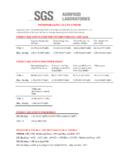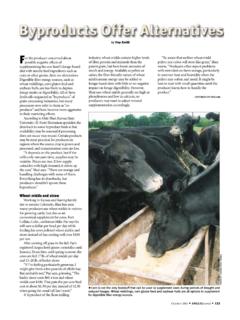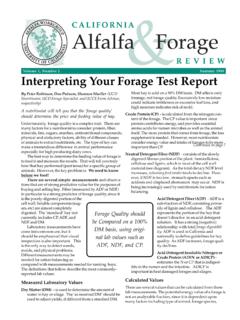Transcription of FORAGE NEWS FROM SGS AGRIFOOD LABORATORIES
1 FORAGE news FROM SGS AGRIFOOD LABORATORIES NEW TMR PACKAGE Historically, wet chemical analysis (Excel Basic or Excel Basic Plus) has been used for SGS AGRIFOOD LABORATORIES to measure nutritional quality of total mixed rations. This analysis is expensive, time-consuming (5day TAT) and with a limited number of tests. In order to provide a more complete, quick and inexpensive overview of the nutritional quality of TMR, SGS AGRIFOOD LABORATORIES is now offering a new package for TMR (NW-TMR) using the speed and proficiency of NIR for only $ This package provides CP, ADP, NDP, SP, ADF, NDF, Lignin, Ash, Fat, Starch predicted by NIR. Calculations will be provided for Undegraded Intake Protein or Bypass protein, Non-fibre carbohydrates and Energy (ADF based and OARDC). Minerals (major and minor) are measured by wet chemistry.
2 The TMR calibration was developed using a broad set of different Canadian TMR samples. Thus, the selected samples represent the expected natural variation nutrient components. To develop the calibration, duplicate samples were analyzed by wet chemistry and two different charges of each sample were scanned as replicates, with the resulting spectra averaged. Modified Partial Least Squares (MPLS) was the equation used to build the regression between the spectral data and the nutritive parameters. Cross validation was employed to avoid overfitting of the equations and to select the optimum number of PLS factors to the final model prediction. Table 1 shows the descriptive statistics and the calibration and cross validation statistics for the TMR samples. All equations showed high correlations confirming the viability of our calibration to analyze TMR samples.
3 With this newly developed NIR calibration curve, TMR s can be routinely monitored to obtain fast and reliable data on chemical composition for optimal performance at the price of typical FORAGE packages. Table 1. Statistics for NIR calibration of TMR samples PARAMETER CP ADF NDF ADP NDP SP LIG SCH ASH FAT Minimum of reference data Mean Maximum of reference data Standard error of calibration (%) Coefficient of determination (R2) Standard error of cross-validation NEW ADDED ANALYSES Effective July 18th 2013, Ash, Fat in all products and NDF-CP (NDP) in fresh FORAGE , hay, haylage and corn silage will be added to NW (NW 40 and NW 41) and NIR 20 packages. Thus, energy values using Weiss equation (OARDC) will be more accurate as less default values will be included into the calculations.
4 Likewise, Iron will be included in all packages containing trace minerals (NW 41, CPM and Equine Complete) whereas 24-h in vitro digestibility of NDF will be included for Hay samples together with that for 48-h. By expanding the list of services, SGS AGRIFOOD LABORATORIES aims to broaden our scope of services and provide more complete test packages to our clients. feed /FORAGES CALCULATIONS Equations used for generating feed and FORAGE calculations are provided below. It is responsibility of the user the use or interpretation given to this information. ENERGY EQUATIONS USED FOR ONTARIO FORAGES (ADF based) Legume ( FORAGE , hay, haylage) Grass ( FORAGE , hay, haylage) Mixed ( FORAGE , hay, haylage, balage) Corn silage/fresh corn silage TDN, % ( *ADF) ( *ADF) ( *ADF) ( *ADF) NEL, Mcal/kg ( *ADF) ( *ADF) ( *ADF) ( *ADF) ENERGY EQUATIONS FOR OTHER FORAGES Oatlage/barlage/misc.
5 Silages (Penn state) Corn+cob meal (dry and high moist) Grain corn/HM grain corn/corn gluten meal Other grains TDN, % ( *ADF) ( *ADF) ( *ADF) ( *ADF) NEL, Mcal/kg ( *ADF) ( *ADF) ( *ADF) ( *ADF) TMRs and miscellaneous mixed feeds TDN, % ( *ADF) NEL, Mcal/kg ( *ADF) ENERGY EQUATIONS Hay (Horses) DE, Mcal/kg ( *ADF)+( *CP)+( *ADF2) TDN, % ( )*100 DIGESTIBLE ENERGY AND METABOLIZABLE ENERGY SWINE: From NRC 1998. Noblet and Perez DE (Kcal/kg) = 4151-(122*Ash)-(64*Fibre)+(38*Fat)+(23*C P) DE (Mcal/kg) = DE (kcal/kg)/1000 ME (Kcal/kg) = ((DE in Kcal/kg)*( ( *CP)) POULTRY: From ANAC 2002. Fisher and McNab ME (MJ/kg) = ( *Cp)+( *Fat)+( *Starch)+( *Sugar) ME (Mcal/kg) = ME (MJ/kg) OARDC Summative Energy Equation of Weiss (National Research Council - Nutrient requirements of Dairy Cattle 7th revised edition, 2001).)
6 This energy calculation is a measure of the principal components in the FORAGE that contribute to energy. Each component has a given digestion coefficient, which multiply each component to finally all the products be added together. TDN1x = (tdNFC + tdFat + tdNDF + tdCP) 7 tdNFC = * (100-NDFN-CP-ASH-FAT)*PAF tdFat = *(FAT-1)* tdNDF = (NDFD*NDF/100) tdCP (forages) = DCP*CP DCPforages = exp ( *(ADF-CP/CP)*100) DCPconcentrate = (1-( *(ADF-CP/CP))) td = True digestible fraction NFC = Non-fibre carbohydrate (%DM) NDF Neutral detergent fibre (%DM) CP = Crude protein (%DM) NDF-CP = Protein bound to NDF fraction NDFD = 48-h in vitro NDF digestibility (%DM) NDFN = NDF - NDF-CP PAF = Processing adjustment factor DCP = Digestible crude protein RELATIVE feed VALUE RFV = (DDM, % DM) x (DMI, % of body weight) / DDM = Digestible Dry Matter = - ( x ADF, %DM) DMI = Dry Matter Intake = 120 / NDF, %DM RELATIVE feed QUALITY RFQ = DMI, % BW)*(TDN, %DM) / (Undersander and Moore, 2002)
7 For legumes (alfalfa, clovers, and legume/grass mixtures) DMI = (120/NDF)+((NDFD-45)* *100 TDN = (NFC* )+(CP* )+((FAT-1)* * )+(NDFn*(NDFD/100)) -7 For warm and cool season grasses DMI = + * * *TDN+ *TDN2+ * * *CP*ADF TDN = (NFC* )+(CP* )+((FAT-1)* * )+(NDFN*(NDFDp/100)) -10 Where: NDFN = NDF - NDF-CP NDFD = 48-h in vitro digestibility of NDF (% of NDF) NDFDp = + *NDFD MILK 2006 See Milk 2006 Spreadsheet for corn silage Milk2006 for Alfalfa and Grass POTENTIALLY DIGESTIBLE NDF (PDNDF) PDNDF = (100-(INDF*100)) Where: INDF (Indigestible NDF) = (LIG, %DM / NDF, %DM) * DIGESTION RATE (KD) KD = (1/EXP((ABS(((LN(-LN(UNIA))-(LN(24-3)))) ))))*100 Where: UNIA = ((1-(24-h IV NDF digestibility/100))-INDF) / (1-INDF) DIGESTIBLE PROTEIN DP = ( *ADP*100/CP) ADJUSTED CRUDE PROTEIN See "Adjusted Crude protein" ADP/CP ratio is >14 and < 20%, then AdjCP = CP ((ADP/CP*100)-7*CP) ADP/CP ratio > 20, then AdjCP = CP ADP * No adjustment is needed when ADP/CP (ratio) is less than 14% CP.)
8 DIETARY CATION-ANION BALANCE (DCAB) DCAB (meq/kg) = (K%*256+Na%*435)-(S%*624+Cl%*282)





